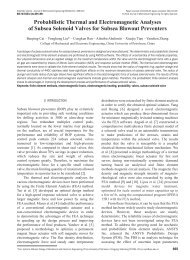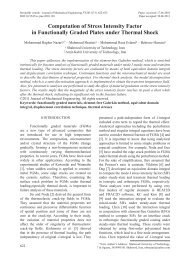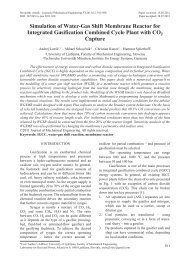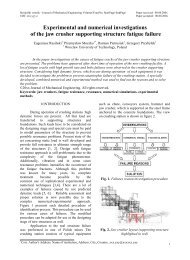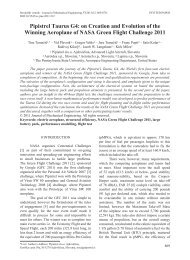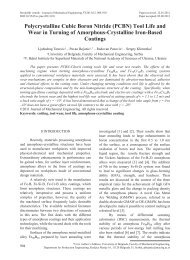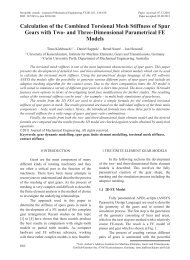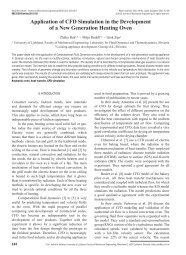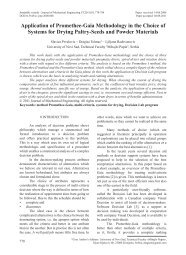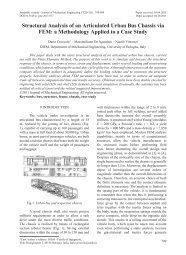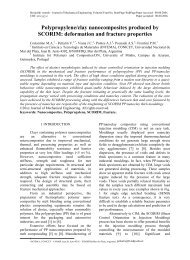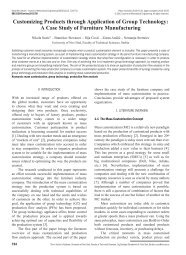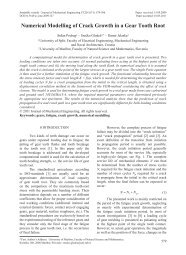Influence of Input Parameters on the Characteristics of the EDM ...
Influence of Input Parameters on the Characteristics of the EDM ...
Influence of Input Parameters on the Characteristics of the EDM ...
- No tags were found...
Create successful ePaper yourself
Turn your PDF publications into a flip-book with our unique Google optimized e-Paper software.
Strojniški vestnik - Journal <str<strong>on</strong>g>of</str<strong>on</strong>g> Mechanical Engineering 57(2011)9, 689-696Table 1. Mechanical and physical properties <str<strong>on</strong>g>of</str<strong>on</strong>g> AISI H13 [10]Temperature[°C]Density[kg/dm 3 ]Specific heat[J/(kg·K)]Electricalresistivity[Ω·mm 2 /m]Modulus <str<strong>on</strong>g>of</str<strong>on</strong>g>elasticity[N/mm 2 ]Thermalc<strong>on</strong>ductivity[W/m·K]20°C 7.80 460 0.52 215×10 3 24.30500°C 7.64 550 0.86 176×10 3 27.70600°C 7.60 590 0.96 165×10 3 27.50Liquidus temperature 1454 °C Solidus temperature 1315 °C[8], <strong>the</strong> optimum utilizati<strong>on</strong> <str<strong>on</strong>g>of</str<strong>on</strong>g> <strong>the</strong> <strong>EDM</strong> processrequires <strong>the</strong> selecti<strong>on</strong> <str<strong>on</strong>g>of</str<strong>on</strong>g> an appropriate set <str<strong>on</strong>g>of</str<strong>on</strong>g>machining parameters that would result in <strong>the</strong>minimum thickness <str<strong>on</strong>g>of</str<strong>on</strong>g> <strong>the</strong> recast layer and depth<str<strong>on</strong>g>of</str<strong>on</strong>g> heat affected z<strong>on</strong>e [9].This paper aims to fill <strong>the</strong> gap in <strong>the</strong>existing literature with respect to <strong>the</strong> processing<str<strong>on</strong>g>of</str<strong>on</strong>g> AISI H13 tool steel with <strong>EDM</strong>. In particular,<strong>EDM</strong> machining experiments were c<strong>on</strong>ducted<strong>on</strong> AISI H13 samples having a hardness <str<strong>on</strong>g>of</str<strong>on</strong>g> 52.7HRC using copper electrode to investigate <strong>the</strong>correlati<strong>on</strong>s between <strong>the</strong> <strong>EDM</strong> parameters (pulse<strong>on</strong>-time and current) and <strong>the</strong> <strong>EDM</strong> characteristics<str<strong>on</strong>g>of</str<strong>on</strong>g> such a workpiece. The output factorsinvestigated were <strong>the</strong> material removal rate, toolwear ratio, surface roughness, as well as <strong>the</strong>thickness <str<strong>on</strong>g>of</str<strong>on</strong>g> white layer and depth <str<strong>on</strong>g>of</str<strong>on</strong>g> heat affectedz<strong>on</strong>e <str<strong>on</strong>g>of</str<strong>on</strong>g> <strong>EDM</strong>ed workpiece. This experimentalstudy results in <strong>the</strong> selecti<strong>on</strong> <str<strong>on</strong>g>of</str<strong>on</strong>g> optimum processparameters to achieve <strong>the</strong> desired <strong>EDM</strong> efficiency,surface roughness, and surface integrity whenmachining such a workpiece material.1 EXPERIMENTAL SETUP AND PROCEDUREThe workpiece material used in this studywas AISI H13 tool steel. Prior to <strong>EDM</strong> processing,<strong>the</strong> workpiece was cut in a cylindrical shape witha length <str<strong>on</strong>g>of</str<strong>on</strong>g> 20 mm and a diameter <str<strong>on</strong>g>of</str<strong>on</strong>g> 20 mm. Themain mechanical and physical properties <str<strong>on</strong>g>of</str<strong>on</strong>g> suchworkpiece material at different temperatures aregiven in Table 1.The tool material was forged commercialpure copper with <strong>the</strong> main properties given inTable 2. The experiments were performed <strong>on</strong> a diesinking <strong>EDM</strong> machine (CHARMILLES ROBO-FORM200) which operates with an iso-pulsegenerator. Machining tests were carried out at fivepulse current settings, as well as four pulse <strong>on</strong>timesettings. As a result, 20 experiments could bedesigned. Each machining test was performed for15 minutes. Table 3 presents <strong>the</strong> experimental testc<strong>on</strong>diti<strong>on</strong>s.Table 2. Physical properties <str<strong>on</strong>g>of</str<strong>on</strong>g> copper electrode[11]Physical properties CopperThermal c<strong>on</strong>ductivity [W/m·K] 380.7Melting point [°C] 1083Boiling temperature [°C] 2595Specific heat [cal/g·°C] 0.092Specific gravity at 20°C [g/cm 3 ] 8.9Coefficient <str<strong>on</strong>g>of</str<strong>on</strong>g> <strong>the</strong>rmal expansi<strong>on</strong>[×10 -6 (1/°C)]17A digital balance (CP2245-Surtorius) witha resoluti<strong>on</strong> <str<strong>on</strong>g>of</str<strong>on</strong>g> 0.1 mg was used for weighing<strong>the</strong> workpieces before and after <strong>the</strong> machiningprocess. The tool wear ratio is defined as <strong>the</strong>volume <str<strong>on</strong>g>of</str<strong>on</strong>g> material removed from <strong>the</strong> tool (V E )divided by <strong>the</strong> volume <str<strong>on</strong>g>of</str<strong>on</strong>g> material removed from<strong>the</strong> workpiece (V W ). Eqs. (1) and (2) show <strong>the</strong>calculati<strong>on</strong>s used for assessing <strong>the</strong> values <str<strong>on</strong>g>of</str<strong>on</strong>g> MRRand TWR.MRR = (M 1 – M 2 ) / ( ρ w·T) , (1)TWR = (V E / V W )·100% , (2)where M 1 and M 2 are <strong>the</strong> weight <str<strong>on</strong>g>of</str<strong>on</strong>g> workpiecebefore and after machining [g], respectively. ρ wis <strong>the</strong> density <str<strong>on</strong>g>of</str<strong>on</strong>g> workpiece [g/mm 3 ], and T is <strong>the</strong>machining time [min].According to Lee and Tai [12], <strong>the</strong>amount <str<strong>on</strong>g>of</str<strong>on</strong>g> white layer thickness (WT) has beenmeasured by measuring this layer’s thicknessat 30 different points by utilizing VEGA\\TESCAN scanning electr<strong>on</strong> microscopy (SEM)and accounting for <strong>the</strong>ir average (Figs. 1 to3). Therefore, <strong>the</strong> machined specimens weresecti<strong>on</strong>ed transversely by a wire electrical690 Shabgard, M. – Seyedzavvar, M. – Oliaei, S.N.B.



